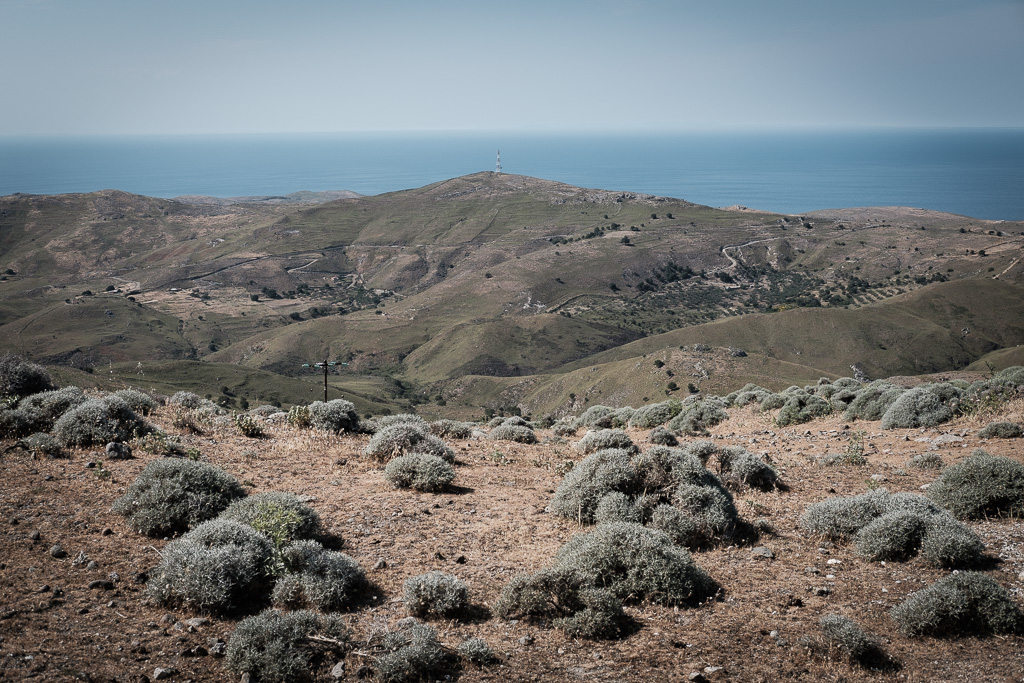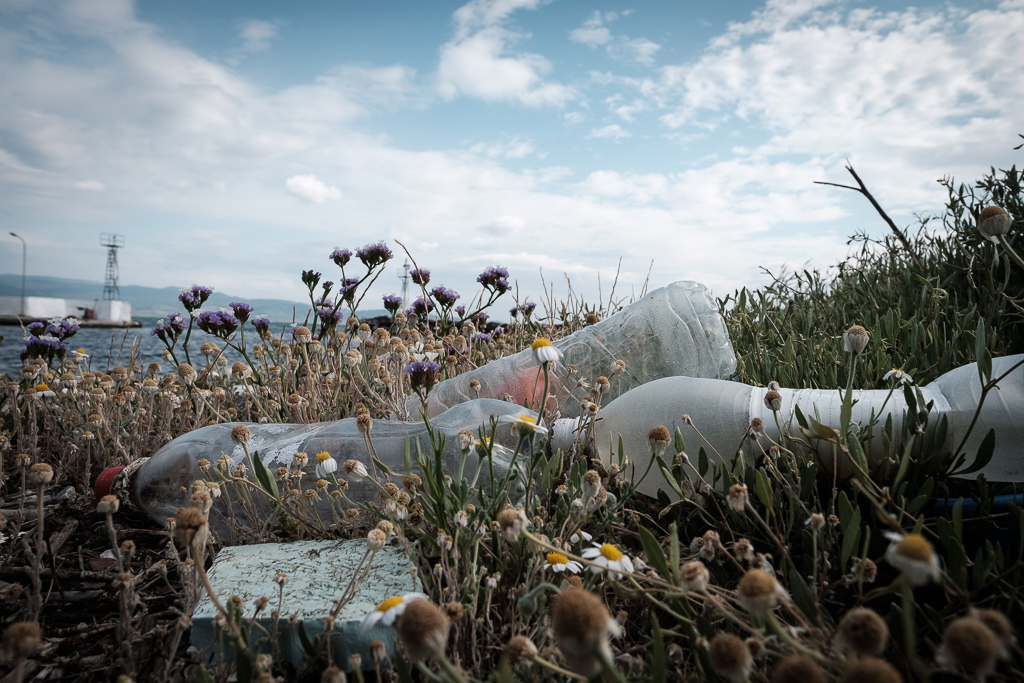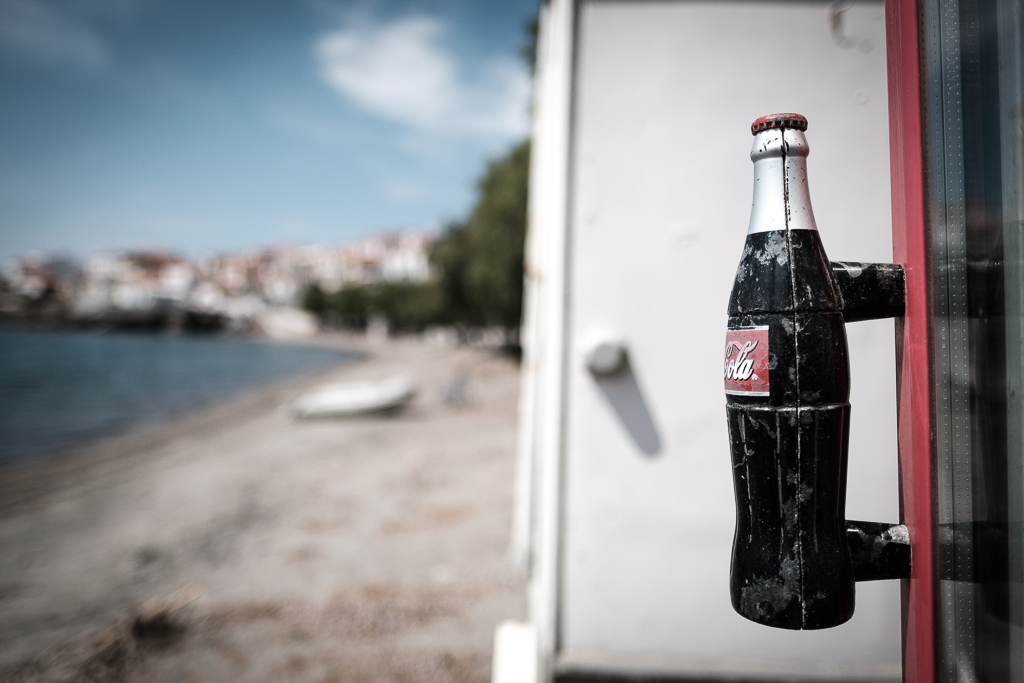The day before yesterday I made a trip with the motorbike to Sigri, a small village located in the very west of Lesbos. It’s quite a nice route even if – at least felt – much further away from Mithimna than the indicated just 57 kilometres make you believe. The winding road leads – as usually here – through a hilly or sometimes even mountainous region that is geographically and botanically interesting though. The island’s landscape changes its face dramatically on the last kilometres to the west. Nothing more can be seen of the omnipresent olive grows – according to some estimates 2 million olive trees exist on the island – or of the pine forests in the mountains of the centre. There is a point on the route from where proverbial after the next bend an almost desert like landscape shows up.

Really impressive, even if this has nothing to do with the actual storyline. OK, I arrived at about 3 pm in Sigri and started to walk around briefly just to stretch my legs. What I have seen and thought during the following two hours can simply be summarized by this post’s title image: crisis! I had no idea which crisis it was – you know, we have plenty of them these days – but for sure one of those was responsible. Maybe the refugees, maybe the financial crisis or the overall threat situation… who knows. Either way, some major changes must have happened here, too sad and too frustrating the whole situation appeared to me, at least at the moment.
Being back in Mithimna that evening I immediately went to my favorite restaurant and described my experiences of the day – connected to the question how bad the situation there really was. The owner of the restaurant – by the way originating from Sigri – looked at me with a mixture of surprise and a lack of understanding. Nothing special was going on in Sigri… no crisis, no misery, she explained to me. In Sigri it’s just not yet tourist season this early in the year. Furthermore, the village has its economic focus on agriculture and fishery and the three months with tourism there are slightly different to those in many other places: it’s more for Greek tourists and mostly for the weekends. All this I was not aware about and nonetheless I came home with plenty of pictures like the one on the title – not only on my memory card.
The next day when I was sighting and editing my pictures I noticed that I have many of other examples like these in my archive. And then – once again – I started to think very carefully about the power of images and the human perception, which interestingly was exactly one of my main topics in the post about my motivation to visit Greece. I still deeply believe that pictures are a powerful instrument to change people’s opinion and mind – and this is the problem at the same time. It may work in so many different ways. Who is responsible for a particular kind of perception? In the first instance it’s the photographer, one may say. And this is right, but just until a certain point. Of course it is of importance what I shoot and how I present this. Is it just one picture or is it part of a contextual documentary? Do I want to communicate a message or is it just a so-called objective observation (which I personally don’t believe to exist). Do I even perhaps want to confuse, misinform, provoke,..? This alone is enough for a wide spectrum of possibilities just from my side as a photographer – and we did not even talk about the viewer’s perception. A few examples will follow now.

An empty beach maybe a sign of…
- a crisis in the tourist sector
- a too expensive or unpopular beach bar
- the first days of low season
- or a photo taken simply too early in the morning 😉

A slightly came down backyard…
- witnesses poverty
- shows just a single abandoned house
- shows that the owner has other priorities
- is a romantic dream of strung out city slickers with too well-ordered lifes 😉

I will not play this little game somewhat further – it becomes clear anyway I think. Almost everywhere in the world one can find places that are ugly or shabby. This itself is not the end of the world and moreover, it does not mean we always must have a possible explanation for this. Even if you don’t find such places on a larger scale you just have to focus on a small detail somewhere and you definitely will strike a bonanza. It’s so simple… if you want this.

More dangerous and fatal than those little and more or less harmless examples are the cases in which non applicable things or messages could be read into an image, like in the short story from the beginning. What do you see below? The end of a fishery village? The coast after a heavy storm? A boat graveyard? Or is it simply a side section of a little harbour where boats are being painted and prepared for the season? Nobody except me knows that behind this scene you could see 30 or more boats in a good condition being in the water.

What about the next picture? Especially if I would title it ‘ On the way from Moria to Mytilene’ (For those who are not familiar with the region: Moria is a small village and at the same time the name of the refugee camp near the island’s capital Mytilene that made the headlines in 2015 and 2016). This would not even be a lie. This wall actually is located exactly there, but how important is this information since for sure I have absolutely no idea who wrote this statement. Refugees? Enraged citizens? Anarchists? Or a drunken tourist? And I have even asked locals about it…

What does such a photo tell us, if anything? Does it represent a prevailing mood here or is it just an occasional and single example found in a hidden location? How does it look like 100m to the right of that place, and how behind me while taking this photograph. The viewer of that photo does not know all this, and sometimes neither does the photographer.
This all is kind of OK and in my case this might only be one photo in one negligible blog. But it started me thinking again about the immense responsibility journalists and media have – and how irresponsible they often deal with this. I don’t want to sing from the same hymn book as the conspiracy theorists and shouters of ‘lying press’ here. However, even for my approach to ask the ‘right’ questions and to find providing answers about what Europe is (I’m writing about this right now in another post) and who The Europeans are, this issue turns out to be not trivial. And it once again confirmed for me to search first for a more overall picture and not to present a story too hasty – the exception proves the rule.
To find back the way out of the dark, it is on the other hand also very simple to practice the other way round, I mean to show the beauty of a place.

However, to be honest, landscape photography and the picturesque I normally leave to others…

I like this sometimes a well, even though it’s in general not my cup of tea. I think I don’t find those other pictures, but they find me… which is a good thing and will also remain so. The ugly and the faulty simply are much more interesting! I just will try to be more cautious with interpretations and conclusions.
By the way, to alter the ugly into the beauty you sometimes just have to step aside a little bit and change your perspective… some blur will deal with the rest. 😉







